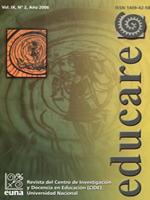El concepto de esquema corporal en niñas y niños con y sin necesidades educativas especiales, de preescolar, segundo y cuarto grado
DOI:
https://doi.org/10.15359/ree.9-2.2Keywords:
concept, body schema, special education needs, preschoolAbstract
his research on the concept of body parts held by preschool, second and fourth grade children with and without special needs provides relevant information on how they construct their body parts concept.
Most of the studied students with special needs show body concepts related to body characteristics and qualities, although some of them also make reference to body skills. It is important to highlight that these concepts are not all too different from those expressed by the group of students without special needs.
The number of body parts listed by students increases with their educational level, as shown in the graphic representations the students made of their bodies. However, most special needs students have greater difficulty in locating body parts and their laterality. We have found that as students with special needs increase their level of education, they are more likely to take on domestic chores and to find school activities more difficult. They also report feeling uncomfortable when people of higher rank make comments related to their bodies. Even so, most students with and without special needs show a positive perception of their bodies and feel respect for themselves.
Based on these findings, we recommend that all educational processes take into account students’ previous knowledge and emphasize not only the teaching of body-related concepts but also concepts related to body image. Teaching activities must also allow students to experience and construct the studied concepts, thus avoiding any wrong learning in the acquisition of concepts about their bodies, or compensating for the educational needs that may derive from a disability.
References
Arce, L. (2003). El uso del libro de aprestamiento para niños del Ciclo de Transición que asisten a jardines infantiles públicos, según la percepción de los docentes del circuito 04 de la provincia de San José. Tesis de Licenciatura. Universidad Nacional.
Ciberarroba. (s.f.) Contenidos psicomotores. En línea: http//www.ciberarroba.com/psicomot/contenidos.html
Fontana, A., Pereira, Z. y Rojas, D. (2005). El concepto de esquema corporal en niños de O a 1 O años con o sin necesidades educativas especiales. Informe final de investigación. Heredia: División de Educación Básica, Universidad Nacional.
Gratty, B. (1982). Desarrollo perceptual y motor en los niños. Barcelona: Editorial Paidós.
Intercole. (s.f.). La imagen corporal. En línea: http//www.intercole.net/portalcnsp/organizacion/weborientacion/orientacion/laimagencorporal.htm
Jiménez, F. (2001). Talleres de actividades para el desarrollo del esquema corporal. Barcelona: Editorial CEAC.
Jiménez, L. (1978). Esquema corporal. Tesis presentada en la Escuela de Educación, Universidad Nacional.
León, A. T., Pereira, Z. y Castro, M. (2003). Análisis de los procesos cognitivos y pedagógicos que se aplican en el aprendizaje de cinco conceptos básicos del programa de Educación Preescolar del Ministerio de Educación Pública y el desarrollo de estos conceptos en 2 ° y 4 ° nivel de la Educación General Básica. Informe final de investigación. Heredia: División de Educación Básica, CIDE Universidad Nacional.
Meléndez, L. (2002). La inclusión escolar del alumno con discapacidad intelectual. Bogotá: Creaciones Alternativas GLARP-IIPD.
Riviere, P. (1966). (Sin título). Disponible: En línea: http/www.espora1didáctica.corn.ar/12-9-66.htm/
Shea, T. y Bauer, A. (2000). Educación Especial. Un enfoque ecológico. México: McGRAW-HILL.
Downloads
Published
How to Cite
Issue
Section
License
1. In case the submitted paper is accepted for publication, the author(s) FREELY, COSTLESS, EXCLUSIVELY AND FOR AN INDEFINITE TERM transfer copyrights and patrimonial rights to Universidad Nacional (UNA, Costa Rica). For more details check the Originality Statement and Copyright Transfer Agreement
2. REUTILIZATION RIGHTS: UNA authorizes authors to use, for any purpose (among them selfarchiving or autoarchiving) and to publish in the Internet in any electronic site, the paper´'s final version, both approved and published (post print), as long as it is done with a non commercial purpose, does not generate derivates without previous consentment and recognizes both publisher's name and authorship.
3. The submission and possible publication of the paper in the Educare Electronic Journal is ruled by the Journal’s editorial policies, the institutional rules of Universidad Nacional and the laws of the Republic of Costa Rica. Additionally, any possible difference of opinion or future dispute shall be settled in accordance with the mechanisms of Alternative Dispute Resolution and the Costa Rican Jurisdiction.
4. In all cases, it is understood that the opinions issued are those of the authors and do not necessarily reflect the position and opinion of Educare, CIDE or Universidad Nacional, Costa Rica. It is also understood that, in the exercise of academic freedom, the authors have carried out a rogorous scientific-academic process of research, reflection and argumentation thar lays within the thematic scope of interest of the Journal.
5. The papers published by Educare Electronic Journal use a Creative Commons License:














 The articles published by Educare Electronic Journal can be shared with a Creative Commons License:
The articles published by Educare Electronic Journal can be shared with a Creative Commons License: 



